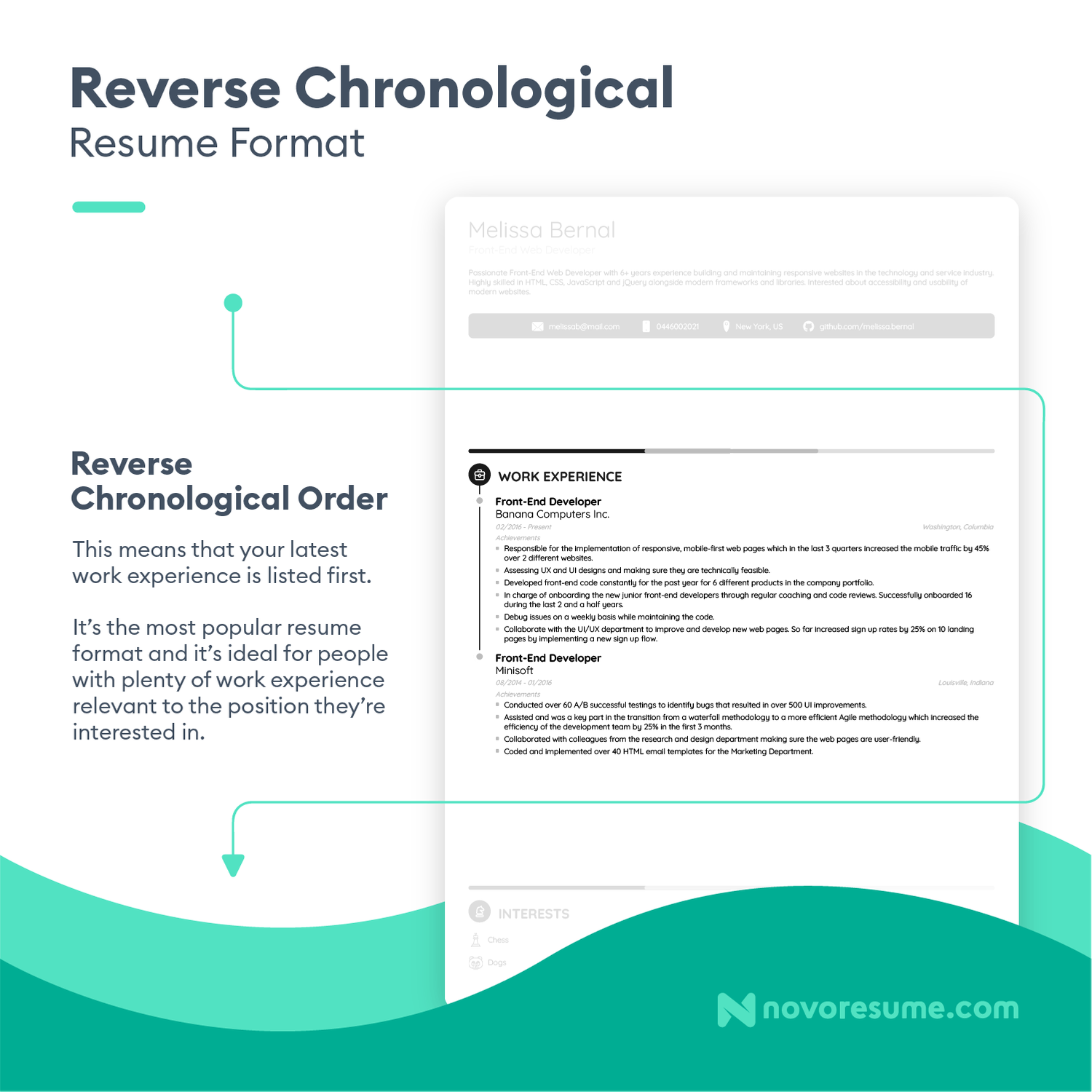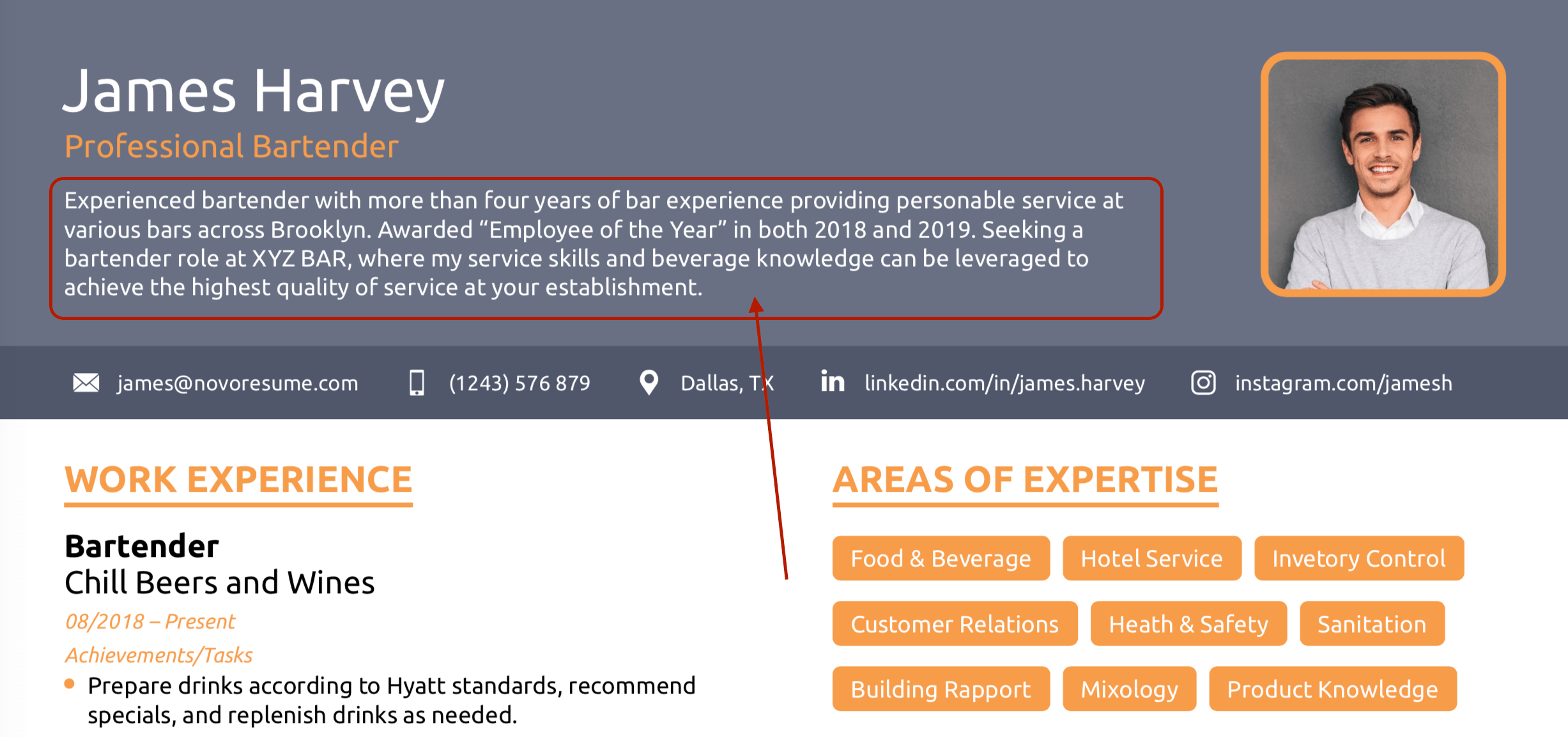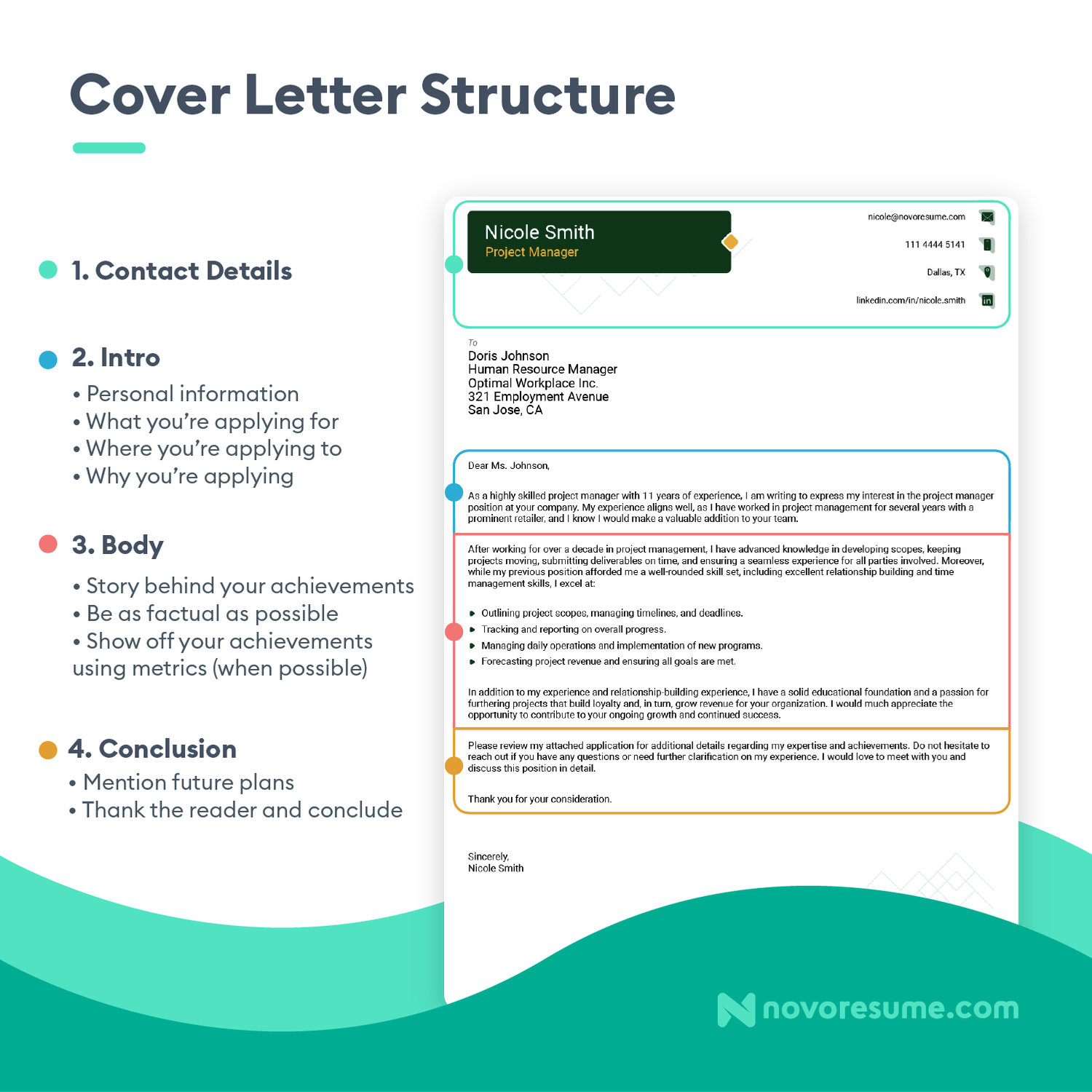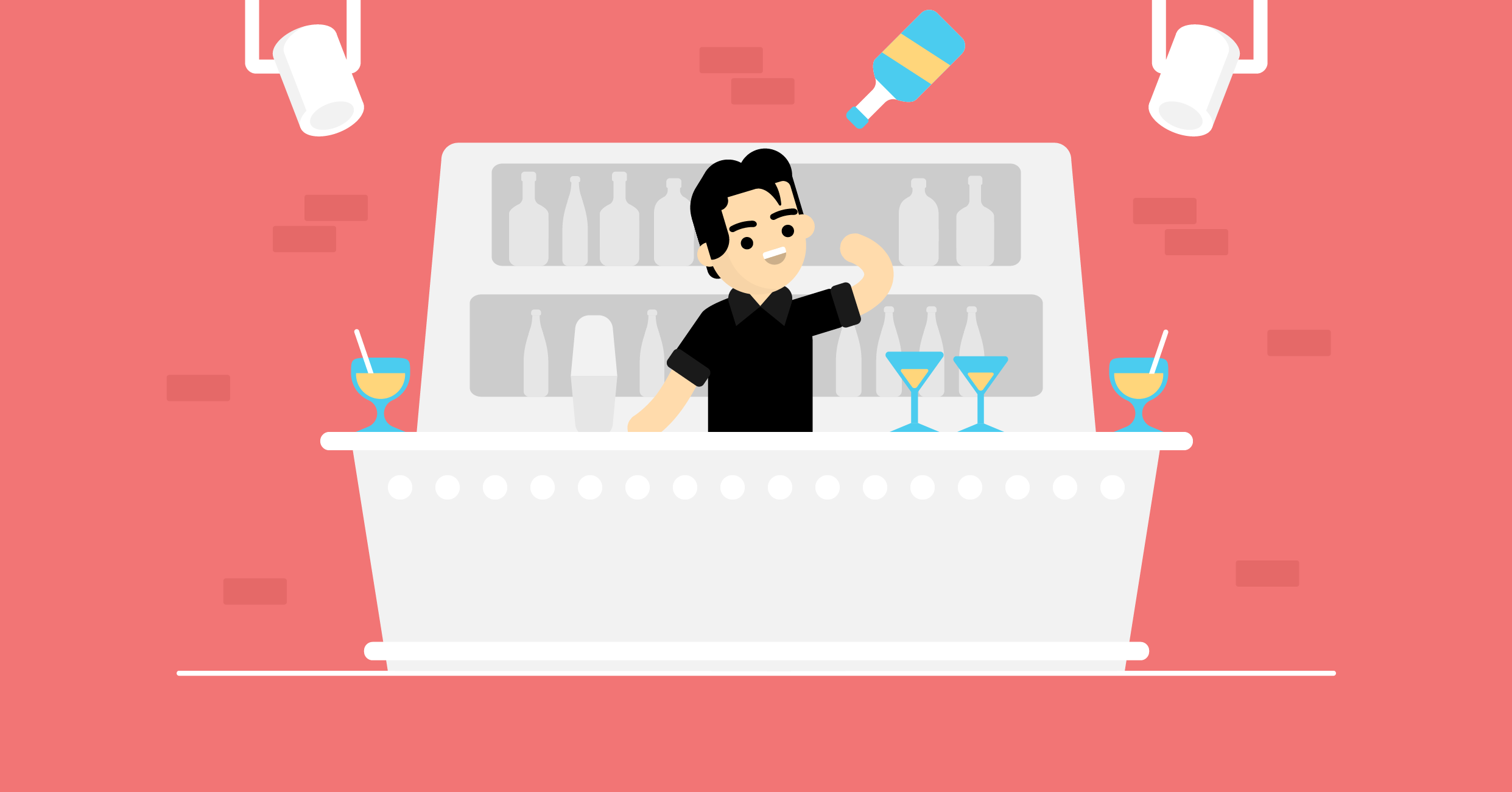You take orders all night long. You serve delicious drinks to your thirsty customers.
But now a new order has come in – a bartender resume!
However, a well-written resume doesn’t flow from a tap.
How do you write a bartender resume, anyway?
Well, just follow this step-by-step guide.
- An example of a finished bartender resume that works
- How to write a bartender resume that’ll fill up your interview diary
- How to make your bartender resume stand out [with top tips & tricks]
Looking for a job in the service industry, but not as a bartender? Here's other resume examples that might be helpful for your job hunt:
- Barista Resume
- Bar and Restaurant Manager Resume
- Waiter Resume
- Server Resume
- Cashier Resume
- Customer Service Resume
- Event Planner Resume
- Receptionist Resume
- Volunteer Resume
How to Format a Bartender Resume
Before the hiring manager can be served, you need to prepare the bar!
But what do we mean by this?
Well, before you start writing, you need to choose a format.
The most common resume format for bartenders is “reverse-chronological”, and it’s one that we always recommend.
Essentially, this format puts your most recent and notable achievements up-top, which allows the hiring manager to immediately see the benefits in hiring you. We recommend all bartenders start with this format.

The following two resume formats can also be used:
- Functional Resume – If you’re confident in your bar skills, but haven’t worked in a bar environment, this resume format is recommended for you. You see, a functional resume focuses on the skills you have, not your experience.
- Combination Resume – Worked in a bar before, which allowed you to perfect your skills? Then you’ll prefer this format. Specifically, the format combines both “Functional” and “Reverse-Chronological” formats.
Once you’ve chosen the correct format for your situation, you need to organize set a few resume layout rules.
For a professional bartender resume, we recommend this layout:
- Margins - One-inch margins on all sides
- Font - A font that stands out, but remains professional
- Font Size - Use a 11-12pt font size for normal text and 14-16pt for headers
- Line Spacing - Use 1.0 or 1.15 line spacing
- Resume Length - Try and stick to a 1-page limit. For guidance, view these one-page resume templates.
Use a Bartender Resume Template
Now, if you have already started your resume, there’s a good chance you’re doing it via a Word document.
Although it’s a great program for simple documents, Word is far from the best tool creating resumes that look professional.
You see, Word isn’t the best for holding structure.
In fact, one small change can cause the whole document to fall apart!
To remove the headache and hours of frustration, use a bartender resume template.
What to Include in a Bartender Resume
Like a Gin & Tonic, keep your bartender resume simple.
The main sections in a bartender resume are:
- Work Experience
- Contact Information
- Skills
- Education
To really impress the hiring manager, you can also add these optional sections:
- Awards & Certification
- Languages
- Interests & Hobbies
So those are the sections you need, but what do you write for each of them?
Let’s find out!
Want to learn more about each of the different sections? View our guide on What to Put on a Resume.
How to Correctly Display your Contact Information
Now, this section is pretty straightforward, but it does require one thing…
Accuracy!
Get this section wrong, and the recruiter may end up calling a very confused pensioner!
The contact information section must include:
- Full Name
- Title - Align this to the role you’re applying for, so “Bartender”
- Phone Number - Check this number carefully
- Email Address - Keep your email professional (firstname.lastname@gmail.com), not like that email from your younger days (hannathespanner@gmail.com).
- (Optional) Location - Applying for a job abroad? Mention your location.
- Paul Duke, Bartender 101-358-6095. pduke@gmail.com
- Paul Duke, Bar King. 101-358-6095. pauliscool@gmail.com
How to Write a Bartender Resume Summary or Objective
Bars are always on the lookout for more staff.
But this fact has only led to an increase in competition.
And with so many applying people for the jobs – the bar is high.
In fact, recruiters receive SO MANY resumes, that they are forced to spend just a few seconds on each resume.
Yes, that’s correct!
Although frightening, this fact highlights the importance of catching the recruiter’s attention.
To do this, use a resume summary or objective.
As a bartender, you know that a friendly first impression is important. Similarly, both resume summaries and objectives can be thought of in the same way. They are short paragraphs that introduce your resume.

They are both opening paragraphs, so what is the difference between a summary and an objective?
A resume summary is a 2-4 sentence summary of your most notable bar experiences and achievements.
- Experienced bartender with more than four years of bar experience providing personable service at various bars across Brooklyn. Awarded “Employee of the Year” in both 2018 and 2019. Seeking a bartender role at XYZ BAR, where my service skills and beverage knowledge can be leveraged to achieve the highest quality of service at your establishment.
A resume objective is a 2-4 sentence paragraph of your goals and aspirations.
- Enthusiastic and friendly cocktail-lover looking for a bartender role at BAR XYZ. Passionate about keeping customers happy and satisfied. Relevant experience includes serving groups of customers at a local restaurant. Skilled in POS, beverage serving, and maintaining a tidy bar.
So, should a member of bar staff use a summary or an objective?
Generally, those who have experience working as a bartender should choose a resume summary. An objective is ideal if you have the necessary skills, but haven’t worked as a bartender before.
How to Make Your Bartender Work Experience Stand Out
Bars love nothing more than a bartender who has “been there and done it”.
As such, your work experience section is the best chance to impress.
Here’s how to structure your work experience section:
- Position name
- Dates
- Company Name
- Responsibilities & Achievements
Bartender
The White Oak
06/2017 – 05/2020
- Served drinks to hundreds of people every night during 10+ hour shifts
- Educated customers on the drinks and cocktail menus
- Always communicated with a personal, yet professional tone, which helped me to win “Employee of the year” for both 2018 and 2019
As you can see, the above example focuses on the applicant’s best achievements. This allows the recruiter to see the benefits to hiring this applicant.
Instead of saying:
“Drink server”
Say:
“Served drinks to hundreds of people every night during 10+ hour shifts”
Bars need employees they can rely on. So it’s a smart idea to show that you’re a hardworking applicant who can cope with long shifts.
What if You Don’t Have Any Relevant Bar Experience?
Maybe you’re still at university, and looking for your first bartender job?
Or maybe, you have experience with serving customers, but never in a bar?
Whatever the situation, the hiring manager needs someone they can trust.
With that said, just because you’ve never worked as a bartender, doesn’t mean you lack the relevant skills and experiences to be a bartender!
You just need to show that you have the bar skills and that you’re keen to learn.
For example, if you’ve worked as a barista in a coffee shop, you can talk about any crossover skills and experiences. Just like a bartender, you would need to be able to deal with groups of people, operate a cash machine, and have a positive attitude.
Use Action Words to Make Your Bartender Resume POP!
Imagine you’re the hiring manager for a minute.
And you’re forced to read the same generic resumes, one after another.
However, the hiring manager’s pain is your gain.
You see, you can make your resume stand out by using some power words:
- Conceptualized
- Determined
- Formulated
- Initiated
- Spearheaded
How to Correctly List your Education
Now, you don’t need a degree to work as a bartender.
But that doesn’t mean you should skip this section.
In fact, all you need to do is enter your education history in the follow format:
- Degree Type & Major
- University Name
- Years Studied
- GPA, Honours, Courses, and anything else you might want to add
B.A in Bar Management
Boston Institute of Culinary Arts
2016-2019
- Relevant Modules: Bar Management, Drink Pairing, Bar Operations, Food Service Fundamentals, and Bar Inventory and Supply Chain]
Now, you don’t need a higher education to be a bartender, so you may have a few questions in regards to this section. Here are the answers to some of the most frequent questions that we get:
- What if I haven’t finished my current education yet?
No big deal. Simply mention the courses you have completed to date.
- Should I include my high school education?
Generally, you should only include your highest form of education. If that happens to be a high school diploma, then list it.
- What do I put first, my education or experience?
For a bartender role, your experiences always come first.
Need more advice? Check out our guide on how to list education on a resume.
Top 12 Skills for a Bartender Resume
Whether you’re a cocktail-craftsman or able to handle 15-drink orders, the hiring manager will want to know.
This is the place for boasting about your most notable skills.
But is there anything specific that the hiring managers want to see?
Well, yes.
You can look at the job ad to identify which specific skills the bar is looking for.
Here are some of the most common bartender skills:
Hard Skills for a Bartender:
- Math (basic calculations)
- POS & cash register
- Cocktail making
- Food and wine pairing
- Health and hygiene protocols
- Barware and bar utensils
- Maintenance of a tidy bar
Soft Skills for a Bartender:
- Personable and friendly
- Endurance (long hours)
- Team player
- Memory and recall
- Conflict resolution
- Don’t get too confident with the soft skills. You see, the recruiter will likely ask for examples of when you have displayed the skill listed. As such, only include skills that you actually posses.
Here’s a more comprehensive list of 150+ must-have skills this year.
What Else Can You Include in a Bartender Resume?
Boom! You should now have nailed all of the essential sections.
But don’t call final-orders just yet.
Your bartenders resume needs to stand out!
Just like a slice of fruit on top of your cocktail, these optional sections can make a significant difference to the end result – whether you get the job or not!
Awards & Certifications
Have you ever won an employee of the month award?
Have you completed any third-party courses, like those on coursera?
Whatever it is, sing it loudly in your resume!
Here’s a quick example:
Awards & Certificates
- “Learning How to Learn” - Coursera Certificate
- “Employee of the Year 2019” - The White Duck
Languages
Applying to a French wine bar?
Then being fluent in French is a good way to shortcut your resume to the top of the pile.
Whether a specific language is required or not, being able to speak multiple languages is impressive – and no one can argue with that!
Rank the languages by proficiency:
- Native
- Fluent
- Proficient
- Intermediate
- Basic
Interests & Hobbies
Now, you may be wondering, “how is my love of dancing related to my work as a bartender?”
Well, it allows the hiring manager to learn more about WHO you are.
So, if you want to show that you’ll be a good addition to the bar staff, make sure to list your personal interests and hobbies.
Here are some hobbies & interests you may want to mention.
Include a Cover Letter with Your Resume
Want an application that stands out?
Then you should write a convincing cover letter.
You see, a resume is vital for giving the important information.
But nothing speaks to a recruiter like a well-written cover letter.
Do it correctly, and you can become an unforgettable candidate.
Oh, and cover letters show that you care about working for their bar.
Here’s a winning structure:

Your cover letter should include the following sections…
Personal Contact Information
Include your full name, profession, phone number, email, and address
Hiring Manager’s Contact Information
Include their full name, position, location, email
Opening Paragraph
To hook the hiring manager, you need an opening paragraph that steals their attention. Use concise language to mention:
- Your name
- The position you’re applying for
- Your experience summary and best achievement to date
The Body
Once you’ve got their attention, you can delve further into the following specifics...
- Why you chose this specific bar
- What you know about the bar culture
- How your skills will be beneficial to the bar
- If there are any similar establishments you have worked in before
Closing Paragraph
Avoid ending the conversation abruptly, you should:
- Conclude the main points of your letter
- Thank the hiring manager for their time and the opportunity
- End with a call to action. This is a great way to take the conversation further. A simple “At your earliest opportunity, I’d love to discuss more about how I can help BAR XYZ” will work.
Formal Salutations
Although the cover letter should have a personal touch, the letter should end in a professional manner. A simple “Kind regards” or “Sincerely” will work a charm.
For extra advice and inspiration, read our step-by-step guide on how to write a cover letter.
Key Takeaways
Get ready:
Because if you follow the steps in this guide, you’re about to become a bartender!
Let’s total up what we’ve consumed today:
- Choose the best format for your specific situation. We recommend the reverse-chronological format and then following the best practices on the layout
- Hook the recruiter with a brief resume summary or objective
- Highlight your most relevant and notable work experiences rather than your bar duties
- Match your resume with a convincing cover letter to stand out


